文章信息
- 孙冬红, 洪玉晓, 陈洪铎, 高兴华
- SUN Donghong, HONG Yuxiao, CHEN Hongduo, GAO Xinghua
- 山药蛋白及其致痒成分分析
- Analysis of Chinese yam proteins and the itch-causing components
- 中国医科大学学报, 2021, 50(12): 1069-1075
- Journal of China Medical University, 2021, 50(12): 1069-1075
-
文章历史
- 收稿日期:2021-03-11
- 网络出版时间:2021-12-07 12:42
山药可用于治疗心血管疾病[1]、糖尿病[2],同时具有降血压[3]、抑制乳腺癌、胃癌细胞生长[4-5]、减轻抗生素相关性腹泻[6]、提高记忆力[7]和免疫调节活性[8-10]等功能。山药中的主要成分有淀粉、多糖、蛋白质、皂苷、尿囊素、多巴胺和黄酮类化合物等[11-12]。山药黏液的主要成分为糖蛋白生物大分子[13]。
山药汁液接触到皮肤,人会感觉到强烈的瘙痒。瘙痒是一种引发搔抓的不适感[14]。组胺及其受体是近几十年研究最透彻的神经介质和受体,在多种瘙痒性皮肤病中起关键作用,组胺导致的瘙痒往往同时伴随风团、红斑和潮红[15]。许多瘙痒的发生往往不伴随风团的出现,且这些瘙痒抗组胺治疗无效,是由非组胺依赖途径引起的[16]。目前,山药引起人体皮肤瘙痒的原因和机制尚未明确。
在20世纪50年代,SHELLEY等[17]研究表明,来自豆科攀缘植物黑藜豆夹毛刺中的一种蛋白酶mucunain可以引起人体瘙痒,这种瘙痒合并烧灼感,且不伴随风团的出现[18]。研究[19-20]表明多种植物的蛋白酶,包括菠萝蛋白酶、无花果蛋白酶和木瓜蛋白酶等,可引发瘙痒,并且瘙痒模式与山药引发的瘙痒一致。本研究以新鲜山药为原料,采用阴离子交换层析分离纯化、皮肤瘙痒评价、液相色谱-质谱联用技术和生物信息学分析等方法筛选出潜在具有致痒作用的蛋白。
1 材料与方法 1.1 材料、试剂与仪器新鲜山药(河南山药种植基地);土豆(辽宁大润发超市);考马斯亮蓝染色试剂盒(上海碧云天公司);Q-HPR(武汉汇研公司);AKTA primer(美国GE公司);电泳系统(美国Bio-Rad公司);凝胶成像系统(北京六一公司);Orbitrap Fusion质谱(美国Thermo公司)。
1.2 实验方法 1.2.1 山药蛋白的分离纯化 1.2.1.1 样品预处理山药洗净切片,-20 ℃冷冻24 h,取500 g室温解冻,加入1 L纯化水匀浆20 min,得到固液混合物,离心(11 500 r/min,4 ℃,25 min)取上清,测定上清pH为6.35,电导率为3.0 mS/cm,此即样品溶液1;将其用3×103超滤膜浓缩至200 mL,以NaOH调节pH至8.0,依次按照0.8 μm、0.45 μm进行膜过滤得到样品溶液2。
1.2.1.2 纯化过程用20 mmol/L Tris,pH 8.0溶液(溶液A)清洗Q-HPR预装柱,将样品溶液2上样,收集完流穿液后,用溶液A平衡预装柱,用20 mmol/L Tris,1.0 mmol/L NaCl,pH 8.0溶液(溶液B)进行线性洗脱5个柱体积,收集不同的洗脱峰。
1.2.1.3 SDS-PAGE电泳将样品溶液2及各组洗脱产物进行SDS-PAGE电泳,考马斯亮蓝染色检测纯化分离条带。
1.2.2 瘙痒评价分别将样品溶液1、样品溶液2及各分离产物以1 mg/mL用纯化水溶解。新鲜土豆与纯化水以1 mg∶1 mL匀浆,离心(3 000 r/min,25 min)取上清为阴性对照。将各组进行人体皮肤瘙痒评价:用浸有上述样品的滤纸片分别贴于健康受试者(共19例)前臂30 min,两滤纸间隔5 cm以上,用数字评分分级法量表进行评分。本研究获得中国医科大学附属第一医院医学伦理委员会审批。
1.2.3 蛋白质液相色谱-质谱联用鉴定 1.2.3.1 液相色谱-质谱联用分析对山药样品进行蛋白提取和胰酶酶解,使用液相色谱流动相溶解肽段,超高效液相系统进行分离。肽段经超高效液相系统分离后注入NSI离子源中进行电离,Orbitrap Fusion质谱分析。
1.2.3.2 质谱结果数据库检索使用Maxquant(https://www.maxquant.org)对二级质谱数据进行检索。
1.2.4 生物信息学分析 1.2.4.1 基因本体论(gene ontology,GO)分析GO对蛋白质组学层面的注释来源于UniProt-GOA数据库(http://www.ebi.ac.uk/GOA/)[21]。使用DAVID数据库(https://david.ncifcrf.gov/)对蛋白进行富集分析。蛋白结构域注释使用基于蛋白序列算法的软件InterProScan以及相应的InterPro结构域数据库( http://www.ebi.ac.uk/interpro/)[22]对鉴定到的蛋白质进行蛋白结构域注释及富集分析。
1.2.4.2 蛋白-蛋白互作分析使用STRING(http://string-db.org)[23]进行分析,设置信度阈值> 0.4,得到鉴定蛋白之间的互作关系。使用在线韦恩分析工具(https://bioinfogp.cnb.csic.es/tools/venny/)对分离后各组分蛋白进行差异分析。
1.2.5 蛋白结构域对比在Pfam数据库中(https://pfam.xfam.org/search)查询,并与注释到的蛋白结构域进行对比。
1.3 统计学分析数据采用SPSS 21和Graphpad Prism 8.0进行数据分析及绘图,对数据进行正态检验,对于不符合正态分布的数据,使用非参数检验(符号秩和检验)进行差异分析。P < 0.05为差异有统计学意义。
2 结果 2.1 山药蛋白质分离纯化采用Q-HPR阴离子交换柱,得到4个较明显的色谱峰,分别命名为洗脱峰1~4(E1~4)。山药样品溶液2的分离纯化图谱见图 1。
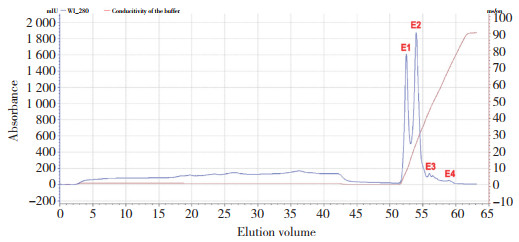
|
| E1-E4, elution peak. 图 1 山药蛋白分离纯化图谱 Fig.1 Plot showing isolation and purification of yam proteins |
2.2 电泳蛋白分离
对样品溶液2、分离组分1、分离组分2、分离组分3及分离组分4进行SDS-PAGE电泳分离,其中,样品溶液2、分离组分1和分离组分2中蛋白主要分布于25×103~35×103,分离组分3蛋白主要分布在75×103,分离组分4蛋白主要分布于30×103~35×103。见图 2。
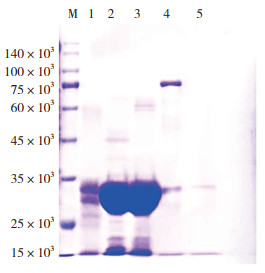
|
| M, marker; 1, sample solution 2;2, component 1;3, component 2;4, component 3;5, component 4. 图 2 蛋白SDS-PAGE电泳分析 Fig.2 SDS-PAGE analysis of the isolated yam proteins |
2.3 瘙痒评价结果
经正态性检验,阴性对照组、样品溶液2和分离组分(2、3和4)瘙痒评分数据不符合正态分布,采用配对样本比较的Wilcoxon符号秩检验。瘙痒评分:土豆水提液均值0.21(阴性对照组)、样品溶液1均值4.58(P < 0.05)、样品溶液2均值3.89(P < 0.05)和分离组分1均值3.21(P < 0.05);分离组分2均值0.37(P > 0.05)、分离组分3均值0.37(P > 0.05)、分离组分4均值0.26(P > 0.05)。见图 3。
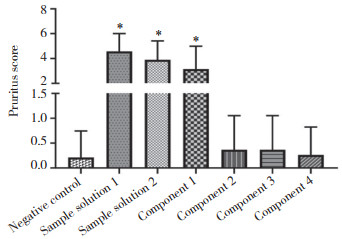
|
| *P < 0.001, compared with control group. 图 3 瘙痒评分统计图 Fig.3 Statistical chart showing pruritus score |
2.4 山药总蛋白定性组学分析结果 2.4.1 山药蛋白质鉴定
通过质谱分析,得到29 695张二级谱图,经蛋白理论数据搜库后,得到可利用有效谱图 10869张。通过谱图解析,共鉴定到7 121条肽段,其中特异性肽段6 191,鉴定出1 529个蛋白质。
2.4.2 山药蛋白注释从GO、蛋白结构域及蛋白描述等方面进行了详细的注释。发现半胱氨酸蛋白酶2(cysteine proteinase 2,CCP2)、B样组织蛋白酶2(cathepsin B-like protease 2,CATHB2),和Oryzain α链(oryzain alpha chain,Os04g0650000)属于木瓜蛋白酶家族,蛋白功能结构域为半胱氨酸蛋白酶。
2.4.3 山药蛋白GO功能分析及蛋白质结构域富集分析为了明确这1 529个蛋白主要涉及的功能,将鉴定到蛋白进行了GO富集分析。GO富集分析显示生物学过程(biological processes,BP)主要富集在柠檬酸盐代谢、二磷酸核苷磷酸化和嘌呤核苷酸生物合成过程等;细胞组分(cellular component,CC)主要富集在多聚核糖体胞浆小核糖体亚单位、细胞连接和呼吸链复合体等;分子功能(molecular function,MF)主要富集在谷胱甘肽转移酶激活、铜离子结合和氧化还原酶激活等(图 4A~4C)。蛋白结构域(protein domain,PD)富集到了磷酸葡萄糖异构酶、Ⅲ类转氨酶和木瓜蛋白酶家族半胱氨酸蛋白酶等(图 4D)。
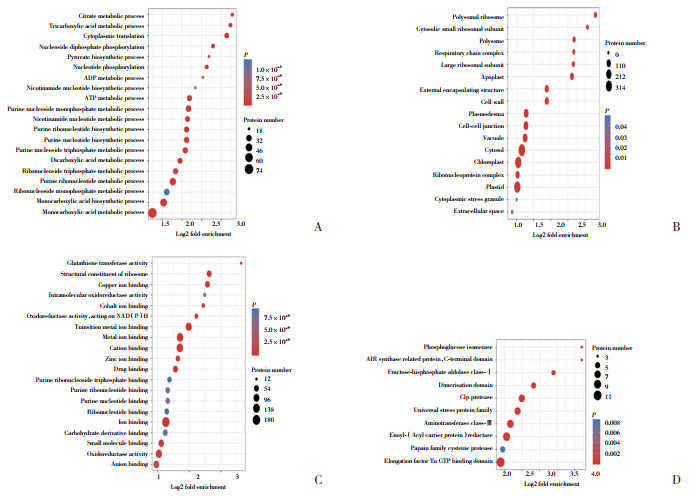
|
| A, biological processes; B, cellular component; C, molecular function; D, protein domain. The size of the points represents the number of molecules and the color of the points from red to blue according to the-log10 P. 图 4 山药蛋白GO功能富集和蛋白结构域富集结果 Fig.4 GO function enrichment and protein domain enrichment of yam proteins |
2.4.4 蛋白-蛋白互作分析(protein-protein interaction,PPI)
为研究蛋白间的相互作用,使用STRING构建PPI网络,发现CCP2、CATHB2和Os04g0650000处于网络的相对核心位置(图 5)。
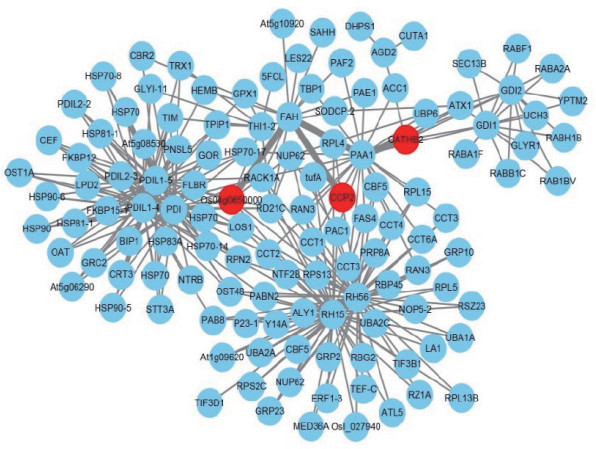
|
| PPI network constructed in Cytoscape. The edges are displayed according to the combined score. The red points represent the three cysteine proteases in yam. 图 5 山药蛋白-蛋白互作网络 Fig.5 Protein-protein interaction network of yam proteins |
2.5 分离纯化后各组分蛋白质谱鉴定及致痒组分的成分分析 2.5.1 质谱鉴定
具有致痒活性的蛋白组分通过质谱分析,共鉴定到990条肽段,其中特异性肽段为872,鉴定到235个蛋白质。另外3个非致痒组分:组分2鉴定到257个蛋白,组分3鉴定到328个蛋白,组分4鉴定到240个蛋白。见表 1。为了鉴别致痒活性组分中的差异蛋白,利用在线韦恩分析工具对4个组分进行分析,识别出致痒组分中含有91个非重叠蛋白,其中包含CCP2(图 6)。
| Total spectrum | Matched spectrum | Peptides | Unique peptides | Identified proteins |
| 37 876 | 2 430 | 990 | 872 | 235 |
| 36 107 | 2 384 | 967 | 867 | 257 |
| 40 394 | 2 276 | 1 261 | 1 089 | 328 |
| 53 968 | 1 027 | 633 | 463 | 240 |
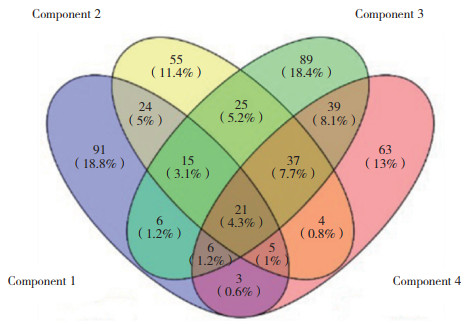
|
| component 1, active component; components 2, 3 and 4, inactive components. 图 6 4个组分韦恩图结果 Fig.6 Venn diagram showing the results of the four components |
2.5.2 模块化分析
为进一步研究具有致痒活性组分蛋白的相互作用关系,通过STRING构建PPI网络并进行模块化分析,发现CCP2是连接2个独立网络的核心分子。见图 7。
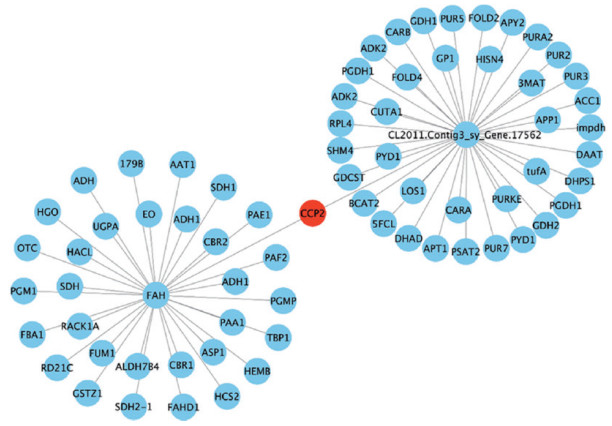
|
| CCP2 is marked with the red point. 图 7 致痒活性组分的蛋白-蛋白互作网络 Fig.7 Protein-protein interaction network of the itch-inducing active component |
2.5.3 CCP2结构域匹配
使用Pfam数据库对CCP2结构域进行匹配,在Pfam数据库中输入CCP2的氨基酸序列。结果显示,该蛋白注释到“木瓜蛋白酶家族半胱氨酸蛋白酶”,CCP2全长198个氨基酸,1-195氨基酸与“木瓜蛋白酶家族半胱氨酸蛋白酶”模型(模型全长218个氨基酸)的23-218序列相匹配。
3 讨论通过对山药蛋白组学的研究,发现1 529个山药蛋白中存在木瓜蛋白酶家族半胱氨酸蛋白酶(CCP2、CATHB2和Os04g0650000)。蛋白结构域富集到木瓜蛋白酶家族半胱氨酸蛋白酶。对山药蛋白进行分离纯化及瘙痒评价,发现分离后组分1具有致痒活性,质谱定性分析鉴定到该组分含有235个蛋白,通过STRING构建PPI网络和模块化分析,发现CCP2处于网络的核心位置且是连接2个独立网络的核心分子。在Pfam数据库中,该蛋白注释为“木瓜蛋白酶家族半胱氨酸蛋白酶”。以上结果提示山药蛋白中存在半胱氨酸蛋白酶。在分离纯化后的活性组分中,核心分子CCP2的一级氨基酸序列与木瓜蛋白酶家族半胱氨酸蛋白酶具有高度同源性。
CCP2在玉米中可以促进玉米种子的发芽和成熟过程[24]。研究[25]表明,植物在自然衰老或耐受胁迫下会导致CCP2 mRNA升高,而在极端胁迫条件下CCP2 mRNA的含量减少,导致蛋白酶活性降低,从而减少蛋白的循环利用并减少代谢产物向植物其余部分的输出。因此,CCP2在植物耐受性上可能起着重要作用。
CCP2作为一种半胱氨酸蛋白酶,其在瘙痒方面的研究未见相关报道。目前已有的研究[26-27]指出,植物中的一些蛋白酶可引发皮肤瘙痒,主要有菠萝蛋白酶、无花果蛋白酶、木瓜蛋白酶及从黑藜豆毛刺中提取的Mucunain,其均属于半胱酸蛋白酶类。研究[19, 28-29]表明,半胱氨酸蛋白酶引发的瘙痒是通过G蛋白偶联受体家族的蛋白酶激活受体(protease activated receptor,PAR)激活引起。该家族由4个成员组成,PAR1~PAR4,它们被蛋白酶水解激活,并向下游传递信号,引起外周机械反应C纤维瘙痒通路的激活。
山药致痒模式为快速出现的瘙痒同时伴有烧灼感,这种瘙痒在皮肤首次接触新鲜山药汁数十秒至数分钟内出现,并且瘙痒时没有风团。山药引起的瘙痒模式和上述蛋白酶引起的瘙痒模式极为相似。基于已有的文献报道和山药分离后的活性评价及成分分析,初步推测山药中CCP2为山药致痒活性成分。山药引起瘙痒的机制可能是山药中的蛋白酶通过PAR的激活引起的非组胺依赖性瘙痒[18, 30]。因此,山药蛋白致痒成分,特别是CCP2的进一步研究有助于建立非组胺依赖的瘙痒模型,为探讨瘙痒机制提供有利工具。
| [1] |
ZHANG L, NG TB, LAM JKW, et al. Research and development of proteins and peptides with therapeutic potential from yam tubers[J]. Curr Protein Pept Sci, 2019, 20(3): 277-284. DOI:10.2174/1389203719666180622094356 |
| [2] |
FAN Y, HE Q, LUO A, et al. Characterization and antihyperglycemic activity of a polysaccharide from dioscorea opposita thunb roots[J]. Int J Mol Sci, 2015, 16(3): 6391-6401. DOI:10.3390/ijms16036391 |
| [3] |
NAGAI T, SUZUKI N, KAI N, et al. Functional properties of autolysate and enzymatic hydrolysates from yam tsukuneimo (dioscorea opposita thunb.) Tuber mucilage tororo: antioxidative activity and antihypertensive activity[J]. J Food Sci Technol, 2014, 51(12): 3838-3845. DOI:10.1007/s13197-012-0910-x |
| [4] |
CHAN YS, NG TB. A lectin with highly potent inhibitory activity toward breast cancer cells from edible tubers of dioscorea opposita cv. nagaimo[J]. PLoS One, 2013, 8(1): e54212. DOI:10.1371/journal.pone.0054212 |
| [5] |
XUE HY, LI JR, LIU YG, et al. Optimization of the ultrafiltration-assisted extraction of Chinese yam polysaccharide using response surface methodology and its biological activity[J]. Int J Biol Macromol, 2019, 121: 1186-1193. DOI:10.1016/j.ijbiomac.2018.10.126 |
| [6] |
ZHANG N, LIANG TS, JIN Q, et al. Chinese yam (dioscorea opposita thunb.) alleviates antibiotic-associated diarrhea, modifies intestinal microbiota, and increases the level of short-chain fatty acids in mice[J]. Food Res Int, 2019, 122: 191-198. DOI:10.1016/j.foodres.2019.04.016 |
| [7] |
CHOI JG, KHAN Z, CHOI SZ, et al. DA-9801, a standardized dioscorea extract, improves memory function via the activation of nerve growth factor-mediated signaling[J]. Nutr Neurosci, 2020, 1-12. DOI:10.1080/1028415x.2020.1743916 |
| [8] |
LI C, LU Y, CHEN X, et al. Analysis of the N-glycoforms and immunoactivity of Chinese yam (dioscorea opposita thunb.) glycoprotein 30CYGP[J]. J Proteome Res, 2020, 19(1): 28-35. DOI:10.1021/acs.jproteome.9b00102 |
| [9] |
NIU XF, HE ZH, LI WF, et al. Immunomodulatory activity of the glycoprotein isolated from the Chinese yam (dioscorea opposita thunb)[J]. Phytother Res, 2017, 31(10): 1557-1563. DOI:10.1002/ptr.5896 |
| [10] |
CHOI EM, KOO SJ, HWANG JK. Immune cell stimulating activity of mucopolysaccharide isolated from yam (dioscorea batatas)[J]. J Ethnopharmacol, 2004, 91(1): 1-6. DOI:10.1016/j.jep.2003.11.006 |
| [11] |
MA F, WANG D, ZHANG Y, et al. Characterisation of the mucilage polysaccharides from dioscorea opposita Thunb. with enzymatic hydrolysis[J]. Food Chem, 2018, 245: 13-21. DOI:10.1016/j.foodchem.2017.10.080 |
| [12] |
ZHANG CQ, CHEN X, DING K. Structural characterization of a galactan from dioscorea opposita Thunb. and its bioactivity on selected Bacteroides strains from human gut microbiota[J]. Carbohydr Polym, 2019, 218: 299-306. DOI:10.1016/j.carbpol.2019.04.084 |
| [13] |
OHTANI K, MURAKAMI K. Structure of mannan fractionated from water-soluble mucilage of nagaimo (dioscorea batatas dence)[J]. Agric Biol Chem, 1991, 55(9): 2413-2414. DOI:10.1080/00021369.1991.10870976 |
| [14] |
GREAVES MW, WALL PD. Pathophysiology of itching[J]. Lancet, 1996, 348(9032): 938-940. DOI:10.1016/s0140-6736(96)04328-0 |
| [15] |
THURMOND RL, GELFAND EW, DUNFORD PJ. The role of histamine H1 and H4 receptors in allergic inflammation: the search for new antihistamines[J]. Nat Rev Drug Discov, 2008, 7(1): 41-53. DOI:10.1038/nrd2465 |
| [16] |
HAN L, DONG X. Itch mechanisms and circuits[J]. Annu Rev Biophys, 2014, 43: 331-355. DOI:10.1146/annurev-biophys-051013-022826 |
| [17] |
SHELLEY WB, ARTHUR RP. Studies on cowhage (mucuna pruriens) and its pruritogenic proteinase, mucunain[J]. AMA Arch Derm, 1955, 72(5): 399-406. DOI:10.1001/archderm.1955.03730350001001 |
| [18] |
JOHANEK LM, MEYER RA, HARTKE T, et al. Psychophysical and physiological evidence for parallel afferent pathways mediating the sensation of itch[J]. J Neurosci, 2007, 27(28): 7490-7497. DOI:10.1523/jneurosci.1249-07.2007 |
| [19] |
REDDY VB, LERNER EA. Plant cysteine proteases that evoke itch activate protease-activated receptors[J]. Br J Dermatol, 2010, 163(3): 532-535. DOI:10.1111/j.1365-2133.2010.09862.x |
| [20] |
ARTHUR RP, SHELLEY WB. The role of proteolytic enzymes in the production of pruritus in man[J]. J Invest Dermatol, 1955, 25(5): 341-346. DOI:10.1038/jid.1955.138 |
| [21] |
HUNTLEY RP, SAWFORD T, MUTOWO-MEULLENET P, et al. The GOA database: gene ontology annotation updates for 2015[J]. Nucleic Acids Res, 2015, 43(database issue): D1057-D1063. DOI:10.1093/nar/gku1113 |
| [22] |
MITCHELL AL, ATTWOOD TK, BABBITT PC, et al. Interpro in 2019:improving coverage, classification and access to protein sequence annotations[J]. Nucleic Acids Res, 2019, 47(D1): D351-D360. DOI:10.1093/nar/gky1100 |
| [23] |
SZKLARCZYK D, MORRIS JH, COOK H, et al. The STRING database in 2017:quality-controlled protein-protein association networks, made broadly accessible[J]. Nucleic Acids Res, 2017, 45(D1): D362-D368. DOI:10.1093/nar/gkw937 |
| [24] |
DOMOTO C, WATANABE H, ABE M, et al. Isolation and characterization of two distinct cDNA clones encoding corn seed cysteine proteinases[J]. Biochim et Biophys Acta BBA-Gene Struct Expr, 1995, 1263(3): 241-244. DOI:10.1016/0167-4781(95)00138-7 |
| [25] |
GRIFFITHS CM, HOSKEN SE, OLIVER D, et al. Sequencing, expression pattern and RFLP mapping of a senescence-enhanced cDNA from zea mays with high homology to oryzain gamma and aleurain[J]. Plant Mol Biol, 1997, 34(5): 815-821. DOI:10.1023/a:1005896713830 |
| [26] |
ARTHUR RP, SHELLEY WB. The role of proteolytic enzymes in the production of pruritus in man[J]. J Invest Dermatol, 1955, 25(5): 341-346. DOI:10.1038/jid.1955.138 |
| [27] |
SHELLEY WB, ARTHUR RP. Mucunain, the active pruritogenic proteinase of cowhage[J]. Science, 1955, 122(3167): 469-470. DOI:10.1126/science.122.3167.469 |
| [28] |
NAMER B, CARR R, JOHANEK LM, et al. Separate peripheral pathways for pruritus in man[J]. J Neurophysiol, 2008, 100(4): 2062-2069. DOI:10.1152/jn.90482.2008 |
| [29] |
REDDY VB, IUGA AO, SHIMADA SG, et al. Cowhage-evoked itch is mediated by a novel cysteine protease: a ligand of protease-activated receptors[J]. J Neurosci, 2008, 28(17): 4331-4335. DOI:10.1523/jneurosci.0716-08.2008 |
| [30] |
JOHANEK LM, MEYER RA, FRIEDMAN RM, et al. A role for polymodal C-fiber afferents in nonhistaminergic itch[J]. J Neurosci, 2008, 28(30): 7659-7669. DOI:10.1523/jneurosci.1760-08.2008 |
 2021, Vol. 50
2021, Vol. 50




